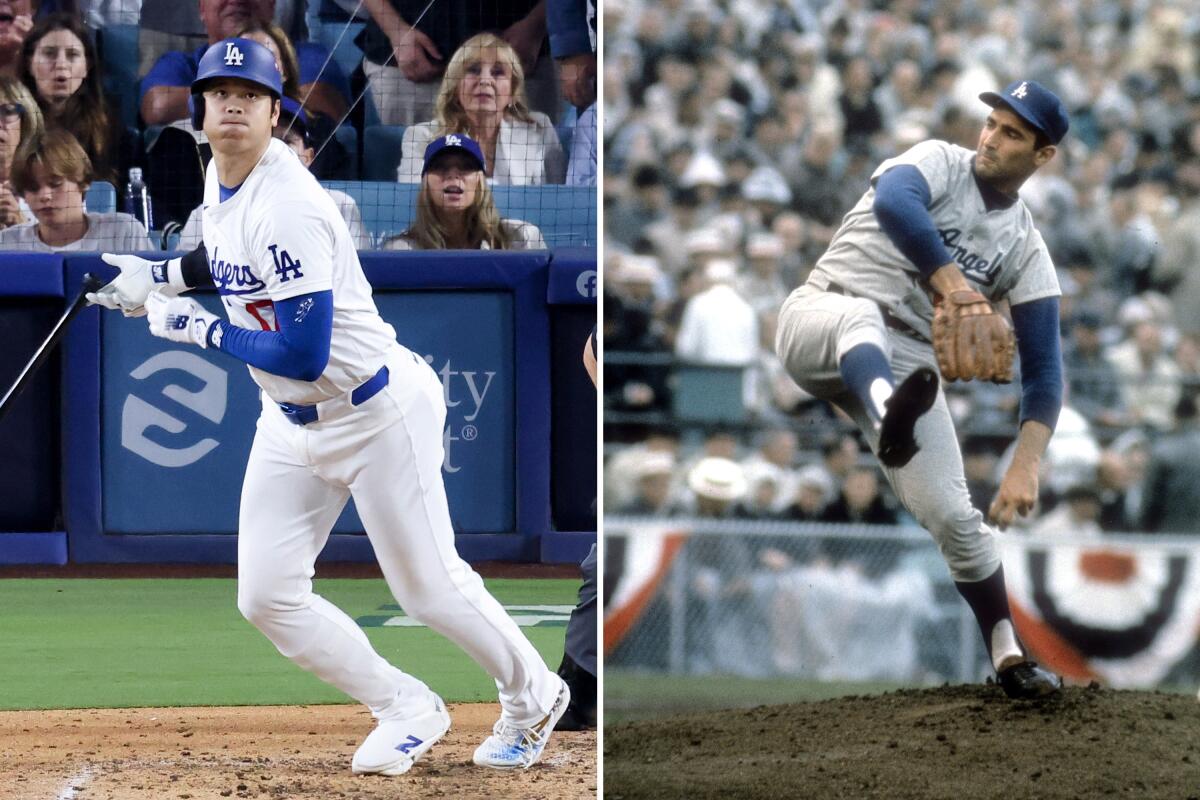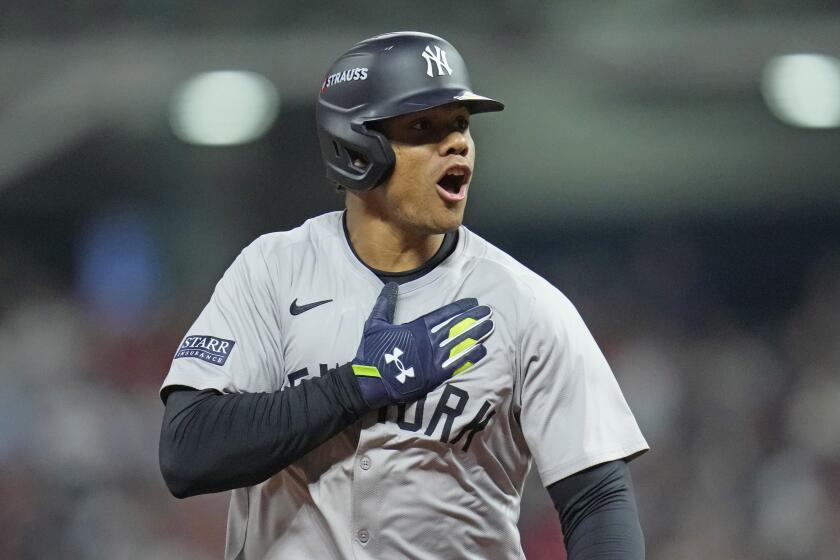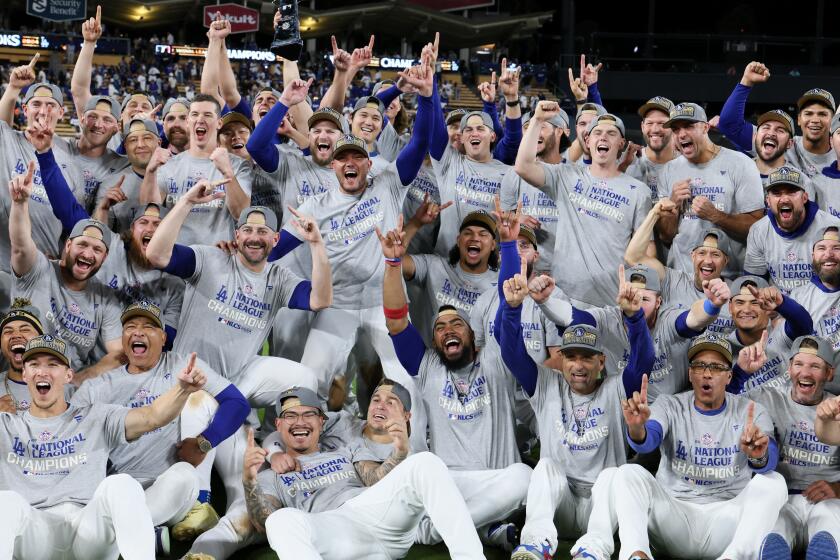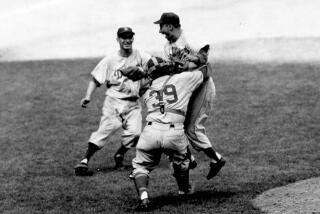Dodgers equaled a record held by 1965 World Series champs. But that’s where similarities end

- Share via
Much has been made of the similarities between the performance of the Dodgers in this year’s National League Championship Series and in the 1965 World Series. As the Dodgers head to their fourth World Series in eight years, holding up their accomplishment to that of their brethren 59 years ago provides both a contrast and a comparison.
What’s the same? Lock-down pitching in the victories and lopsided scores throughout. The ’65 Dodgers were the only team in baseball history until the current Dodgers to have the first six games of a postseason series decided by four or more runs.
Back when the postseason consisted only of the World Series, the ’65 Dodgers defeated the Minnesota Twins in seven games. They gave up only two runs in their four victories — including three shutouts — while giving up 18 runs in three one-sided losses.
The current Dodgers notched two shutouts in the four wins over the New York Mets (after shutting out the San Diego Padres in the last two games of the NL Division Series). Yet they surrendered 19 runs in two losses to the Mets.
But dig deeper and the differences between these Dodgers teams are staggering and stark, speaking directly to how baseball has changed in philosophy, planning and execution.
Looking back at the Dodgers’ path through the postseason before their victory over the New York Yankees in the 2024 World Series.
Let’s start with pitching.
The ’65 Dodgers had three starters gobble up 49.2 of the 60 innings in the series. The names are familiar: Sandy Koufax (24 innings in three starts; 0.38 earned-run average), Claude Osteen (14 in two; 0.64 ERA) and Don Drysdale (11.2 in two; 3.86 ERA). Four relievers shared the other 10.1 innings.
That’s right, the ’65 Dodgers needed only seven pitchers to navigate a seven-game World Series. The current Dodgers needed seven just to get through the Game 6 clincher against the Mets.
No reliever on the ’65 Dodgers pitched more than 3.2 innings against the Twins. Koufax threw two complete games. Osteen and Drysdale each threw one ... Back up for a sec: Koufax pitched a shutout in Game 5 on Oct. 11 and another shutout in Game 7 on Oct. 14. No wonder he’s considered the greatest Dodgers pitcher of all time and no wonder he was forced to retire a year later because of excruciating arm pain.
The current Dodgers employed five different starters who combined for a paltry 21.1 innings. Jack Flaherty pitched seven innings in Game 1 but no other starter went even five innings. The Dodgers leaned on 10 different relievers — including two who also started games — to eat up 41.2 innings and land in the World Series against the New York Yankees.
With the World Series starting Friday at Dodger Stadium, here are nine concerns the Dodgers should have about the AL champion New York Yankees.
The World Series was simply a continuation of the regular season for the ’65 Dodgers. Koufax (26-8 in 335.2 innings), Drysdale (23-12 in 308.1 innings) and Osteen (15-15 in 287 innings) made 127 starts and combined to pitch 931 of the team’s 1,476 innings. Only nine other pitchers were called upon all season.
The current Dodgers used 17 different starting pitchers — remember Elieser Hernández? — and gave new meaning to the term 40-man roster by employing precisely that number of pitchers to get through 1,445.2 regular-season innings.
How do the offenses compare? They don’t.
The ’65 Dodgers couldn’t hit a lick. They went 97-65 in the regular season while averaging only 3.75 runs a game. Home runs were as rare as a left-handed catcher, with outfielder Lou Johnson and rookie second baseman Jim Lefebvre leading the team with 12 each. Ron Fairly drove in a team-high 70 runs.
The current Dodgers went 98-64 while averaging 5.2 runs a game. Eight players hit at least a dozen home runs, led by Shohei Ohtani’s 54, and the team blasted 233, nearly three times the 78 homers hit in ’65.
Clayton Kershaw, Mookie Betts and Walker Buehler are among the 2020 Dodgers that are would to finally celebrate a World Series title with fans in L.A.
The ’65 Dodgers like to run, led by Maury Wills and his league-leading 94 stolen bases. The current Dodgers are more efficient on the base paths, however, successful in 86% of their 159 stolen-base attempts. The ’65 Dodgers were successful in only 69% of their 249 attempts.
The trend carried over into the postseason. The ’65 Dodgers stole nine bases during the World Series but were caught six times. The current Dodgers were successful in six of seven attempts against the Mets.
The robust offense of the current Dodgers continued as their 46 runs were the most ever in an NLCS. A major reason was their patience — they drew a record 42 walks.
The ’65 Dodgers drew only 13 walks en route to scoring 24 runs in the World Series, but 21 runs came in their four victories, resulting in the abundance of one-sided outcomes that invited comparisons to the current team.
Tommy Edman is one of the newest players in the Dodgers’ clubhouse, but that didn’t stop him from making an MVP-caliber impact against the Mets in the NLCS.
For the most part, however, differences were more pronounced than similarities, and illustrate how much baseball has changed in 59 years.
Postseason series with six consecutive games decided by four or more runs
2024 NLCS
Game 1: Dodgers 9, Mets 0
Game 2: Mets 7, Dodgers 3
Game 3: Dodgers 8, Mets 0
Game 4: Dodgers 10, Mets 2
Game 5: Mets 12, Dodgers 6
Game 6: Dodgers 10, Mets 5
1965 World Series
Game 1: Twins 8, Dodgers 2
Game 2: Twins 5, Dodgers 1
Game 3: Dodgers 4, Twins 0
Game 4: Dodgers 7, Twins 2
Game 5: Dodgers 7, Twins 0
Game 6: Twins 5, Dodgers 1
Game 7: Dodgers 2, Twins 0
More to Read
Are you a true-blue fan?
Get our Dodgers Dugout newsletter for insights, news and much more.
You may occasionally receive promotional content from the Los Angeles Times.















